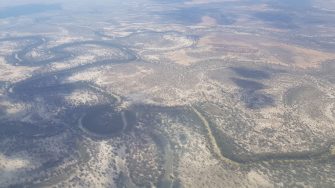
Date: Tuesday, October 6, 2020
Project: Eastern Australian Waterbird Survey
Observers: Richard Kingsford UNSW, Paul Wainwright DEWHA
Pilot: James Barkell NSW National Parks & Wildlife Service DPIE
This year continues to be the most extraordinary of extraordinary years. As for all of us, Covid 19 has thrown our aerial survey planning into disarray. In every previous year we have headed north to Queensland to do the first two weeks of survey in early October before it gets too hot. Not in 2020. We are hoping to get into Queensland in the next month or so, depending on approvals and covid cases in NSW. We had no word come take-off time. So instead we are now confined to New South Wales and South Australian surveys. At least we know we can do Band 6, the most southern most survey band in Queensland without setting foot in Queensland which is great. We can refuel in NSW.
First stop Coolmunda Dam, just over the border in Queensland, after making sure of all our navigation equipment and refueling at Armidale. The dam had a few hundred waterbirds, including pelicans, swans, grey teal and pied stilts. It has better shallow water areas than most other large dams. The temperature quickly rose to 34oC which makes for a bumpy ride. We headed west across the cotton growing areas of the Border Rivers, near Goondiwindi. I had anticipated more water in the off river storages up here. Many were dry and a few had some water in them. It’s when they are shallow that they become useful habitat for some waterbirds. Otherwise these large dams do little for the aquatic ecology of the river.
Along the Macintyre River, Boobera Lagoon was reasonably full of water but very few waterbirds. There was only the odd yellow-billed spoonbill on this fairly long expanse of water. Then we headed west, surveying the few off-river storages in the Border Rivers, the Macintyre and the Weir River, up to the Culgoa near Dirranbandi which held water. In big flood years many of these are full. As usual, they had virtually no waterbirds, apart from the odd pelican or cormorant. Their depth precludes them as good habitat for many waterbirds that need shallow water to feed. It was then on to the Ramsar-listed Narran Lakes. This wonderful wetland system is one of the most spectacular in the Murray-Darling Basin when it floods. In really large floods, large colonies of straw-necked ibis, glossy ibis and Australian white ibis establish and breed. We were keen to see if any of the birds were breeding. They need to top a high threshold of flooding for this to happen. It needs a lot of water to come down the Narran River.
There was only a small amount of water in the channels to the west of Clear Lake, which was drying back. There were probably only about a hundred or so waterbirds, including pelicans, avocets and a handful of small migratory wading birds from the Northern Hemisphere.
There were only three glossy ibis, nothing particularly spectacular for Narran which can have hundreds of thousands of breeding ibis. Unfortunately, there wasn’t enough water this year to trigger any breeding, now with most of it drying right back. Management of water here is an ongoing challenge. We have analysed waterbird breeding on Narran and shown significant declines in the frequency of breeding because not enough water reaches the wetland any more, given the extractions upstream. Sadly, its ecological character, an obligation for governments to maintain, will continue to decline over time. We headed for Bourke overnight, passing parts of the Darling River floodplain which showed the imprint of a recent flood but the Darling River and its floodplain were dry with water primarily confined to its main channel. It will need a big flood to kick start this river again.
Blog by Richard Kingsford
